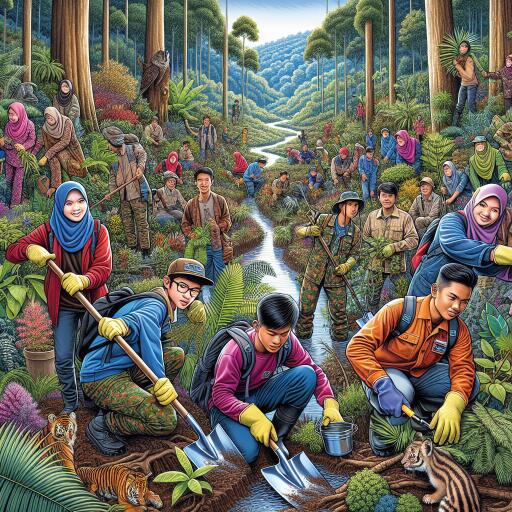
#GenerationRestoration: How Malaysian Teens Are Leading the Charge in Biodiversity Conservation – BebasNews
In the heart of Malaysia, a country celebrated for its breathtaking natural diversity, a passionate movement arises. Facing significant environmental threats, from land development, pollution, to the dangers of climate change, Malaysia’s ecological treasures teeter on the edge of critical endangerment. Within this crisis, a beacon of hope shines through the commitment and actions of its youth, the #GenerationRestoration, spearheading a transformative approach towards conserving biodiversity for generations to come.
As a megadiverse nation, ranked 12th globally for its rich array of species and ecosystems, Malaysia boasts extensive forests covering approximately 60% of its land and marine protected areas vital for coral reefs, seagrasses, and mangrove forests. However, amidst this natural wealth, challenges such as illegal poaching and a high number of threatened species, with 1,141 documented by the 2008 IUCN Red List, highlight the urgency for concerted conservation efforts.
The Kunming-Montreal Global Biodiversity Framework (GBF), adopted at the COP 15, delineates ambitious targets aimed at creating a harmonious relationship with nature by 2030 and 2050. These goals focus on expanding natural ecosystems, preventing extinctions, and promoting the sustainable use of biodiversity. Such comprehensive efforts underscore the essential roles all societal sectors play, especially the youth, in turning these objectives into reality.
Malaysia’s National Policy on Biological Diversity 2016-2025 has set tangible aims to deeply involve the youth in nature conservation, targeting the engagement of at least 500,000 young individuals in ecological activities by 2025. Through initiatives that enrich biodiversity literacy, enhance environmental education among teachers, and support ventures like the Rakan Alam Sekitar programme, Malaysia is laying the groundwork for nurturing the environmental leaders of tomorrow.
The move towards urban biodiversity conservation opens new avenues for youth participation. This initiative not only focuses on the safeguarding of green spaces and wildlife habitats but also encourages innovative contributions from young minds. They are envisioned to lead in growing awareness, sharing sustainable practices, and ensuring their voices advocate for future-oriented, international ecological policies.
Educational reforms emphasizing interdisciplinary conservation studies are deemed crucial for cultivating a society that values and actively engages in environmental stewardship. The call for ‘transformative education’ by the Global Youth Biodiversity Network (GYBN) emphasizes the importance of developing an informed and proactive citizenry. Contemporary educational strategies, incorporating technology like augmented and virtual reality, stand as vital tools for enhancing learning experiences in biodiversity conservation, making lessons more engaging and effective.
Furthermore, the power of social media as a tool for ecological advocacy cannot be overstated. Youth-driven viral campaigns have the potential to rapidly spread awareness, push for policy reforms, and promote individual and corporate responsibility towards the environment. Similarly, artificial intelligence (AI) is emerging as a critical ally in biodiversity conservation, offering advancements in habitat monitoring, wildlife protection, and data analysis which, when combined with the enthusiastic engagement of youth, can significantly amplify conservation efforts.
The Youth Societies and Youth Development Act 2007 emphasizes the value in preparing youngsters for roles in environmental leadership. It’s clear that the active participation and empowerment of youth are indispensable for achieving biodiversity conservation goals. With concerted efforts among government bodies, educational institutions, and civil society, the implementation of Malaysia’s National Policy on Biological Diversity 2016-2025 can truly make a significant impact.
As the 2025 milestone approaches, there’s an intensifying call to action for all involved. Malaysian youth, in particular, are urged to band together, constructing a resilient and vibrant foundation for biodiversity conservation efforts. Their collective action and advocacy can carve a path towards a sustainable future, safeguarding Malaysia’s natural heritage for the prosperous benefit of all.
The mantle of responsibility rests on the actions we undertake today. With the dedication and passion of #GenerationRestoration, the prospects for a biodiverse and ecologically balanced world appear bright. Together, the youth of Malaysia stand ready to shape a legacy of environmental stewardship that will resonate for generations to come.





Leave a Reply